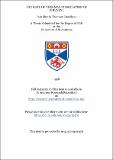The rate of thermal dissociation of direnzyl
Abstract
1) The most recent work on the pyrolysis of dibenzyl suggested that a thermal equilibrium:- PhCH₂CH₂Ph == 2 PhCH₂- was set up as a preliminary to decomposition. The aim of this research was to test this idea by heating mixtures of PhCH₂CH₂Ph (M.W. 182) and PhCD₂CD₂Ph (M.W. 186) and following mass spectrometrically the growth of PhCH₂CH₂Ph (M.W. 184) formed by radical recombination. 2) A four stage synthesis of deuterated dibenzyl was developed and used to prepare dibenzyl of 95% isotopic purity with the composition:- PhCD₂CD₂Ph, 81%; PhCD₂CDHPh, 18 %; PhCDHCDHPh, 1%. PhCH₂CD₂Ph was synthesized by the same sequence of reactions. 3) In order to provide the necessary experimental equipment, the following items have been developed and constructed and descriptions of them are given in this Thesis:- a) a 2 litre reaction vessel with an electronically controlled furnace was arranged with a gas circulating system feeding the inlet of a mass spectrometer; b) an existing mass spectrometer was extensively modified in order to give resolution of 1 in 200:- i) the spectrometer tube was stiffened and accurately re-aligned; ii) the ion collector unit was made detachable and its construction improved; iii) a new ion source was designed and built to the required high accuracy; iv) a new scanning unit was built for variation of the magnetic field. 4) The rate of formation of PhCH₂CD₂Ph was followed in mixtures of PhCH₂CD₂Ph and PhCD₂CD₂Ph at pressures of 0.08 to 0.66 mm. in the reaction vessel, and at pressure up to 142 mm. in sealed tubes, using temperatures between 400° and 500°C. Data were also obtained on the rate of decomposition of PhCH₂CH₂Ph alone in similar systems. 5) The rate of radical exchange was found to be first order, independent of surface and of pressure of added A, N₂, D₂, and O₂. The decomposition reaction was shown to be 1.5 order at low pressures, and tended to first order at high pressures. At lower pressures it was much slower than the radical exchange. 6) A rate equation for radical exchange in terms of the rate of dissociation of dibenzyl, making due allowance for the simultaneous decomposition of dibenzyl has been developed and applied in the lower pressure region where exchange was of major importance. It gives:- kf sec⁻¹ = 10 ¹⁴.⁰³ exp -6000/RT 7) The energy of activation in 6) has been identified with D(PhCH₂-CD₂Ph) in dibenzyl. This value has been discussed in relation to current data on the heat of formation of the benzyl radical and bond dissociation energies in benzyl compounds, notably D(PhCH₂-H) in toluene. 8) The energy of activation for the decomposition was found to be 47 kcal and the nature and proportions of the reaction products were established and compared with previous work. The proportions of side-chain deuterated toluenes formed were consistent with a deuterium isotope effect of 2 or less, and with toluene being made by the abstraction of hydrogen from the central carbon atoms of dibenzyl by benzyl radicals. Benzyl radicals were also shown to react with deuterium to form toluene.
Type
Thesis, PhD Doctor of Philosophy
Collections
Items in the St Andrews Research Repository are protected by copyright, with all rights reserved, unless otherwise indicated.

